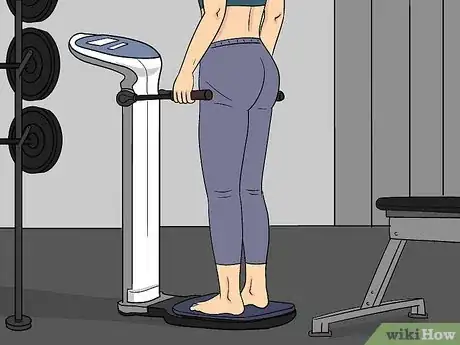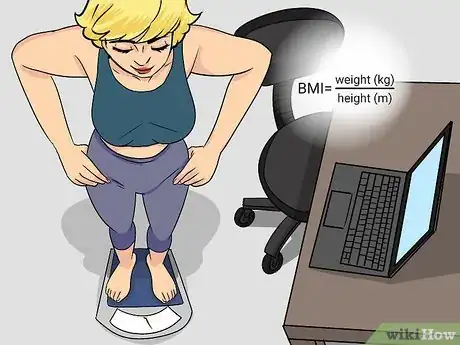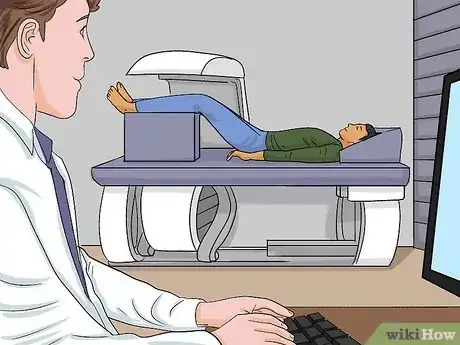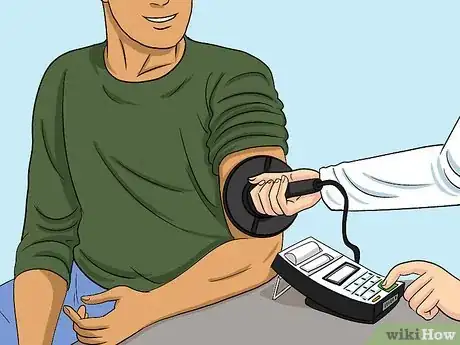This article was co-authored by Claudia Carberry, RD, MS. Claudia Carberry is a Registered Dietitian specializing in kidney transplants and counseling patients for weight loss at the University of Arkansas for Medical Sciences. She is a member of the Arkansas Academy of Nutrition and Dietetics. Claudia received her MS in Nutrition from the University of Tennessee Knoxville in 2010.
There are 7 references cited in this article, which can be found at the bottom of the page.
This article has been viewed 175,825 times.
Body fat percentage is the mass of fat that your body holds divided by its total mass, which includes the weight of everything else (muscle, bone, water, etc.). Body fat percentage can be a pretty good indicator of disease risk. For example, the higher your percentage of body fat (especially if it's concentrated around your abdomen), the higher your risk of cardiovascular disease, diabetes, osteoarthritis, and certain types of cancer.[1] There are many different ways of measuring body fat percentage, ranging from old-school methods (such as calipers) to high-tech body scans. Calculating body fat at home can give you a very good approximation, but the most accurate methods rely on expensive equipment operated by healthcare professionals.
Steps
Calculating Body Fat and BMI at Home
-
1Measure your waist with a tape measure. Measuring waist circumference with a tape measure also helps screen for possible health risks (mentioned above) that come with being overweight or obese.[2] More specifically, if most of your fat is around your waist (termed belly fat) rather than lower at your hips, then you’re at a higher risk for cardiovascular and various other diseases. To correctly measure your waist, stand up wearing just your underwear and place a tape measure around your lower abdomen, below your bellybutton and just above your hip bones. Breathe in and then measure your waist just after you fully breathe out.
- When measuring waist circumference, apply the tape so that it makes contact with the skin and conforms to the body, but does not compress the underlying soft tissues.
- Waist sizes greater than 35 inches for women and greater than 40 inches for men represent greater risk of disease.
- The U.S. Navy method incorporates waist, hip, and neck circumference along with height and weight to determine an estimation of body density and fat percentage.[3]
-
2Use calipers to measure body fat. The caliper method (also called skinfold or pinch test) involves pulling your subcutaneous fat away from your muscles at certain points and pinching it with measuring calipers. These measurements are then converted to an estimated body fat percentage by an equation — some formulas require only three body measurements, others require as many as seven. Although the caliper method doesn't give an accurate reading of actual body fat percentage, it's a reliable measure of body composition change over time if the test is done by the same person and technique (only a 3% error). Although, measurement error is higher for very lean and obese people. You can buy calipers and have a friend or family member measure you, or get the test done at a fitness club, health clinic or hospital.
- It's very important when doing the caliper test to use fixed pressure on all the points you measure.
- Ideally, have a trained professional do your skin caliper measurements to ensure accuracy.
- Skinfold-based body fat estimates depend somewhat on the type of caliper used and technique. As well, it measures only one type of fat: subcutaneous adipose tissue (fat under the skin).[4]
Advertisement -
3Measure your bioelectrical impedance. Bioelectrical impedance is a method of measuring the fat composition of your body, in comparison to other tissues, by its resistance to electricity.[5] Fat tissue does not conduct electricity, whereas muscle and bone tissue do (albeit poorly). As such, you're measuring how low levels of electricity flow through your fat tissue versus the other tissues in your body. Bioelectrical impedance is reportedly about 95% accurate depending on your body's water content, which fluctuates with exercise, diet, sweating, hydration and use of alcohol or drugs. This method does not require specialized personnel and the equipment is not expensive to buy — most gyms and physical therapy offices have them to use for free.
- You can either stand barefoot on metal plates that send an electrical current through your body (it looks similar to a regular weight scale), or grip a hand-held device (with both hands) that does the same thing.
- To get the most accurate results, don't eat or drink for 4 hours prior to testing; don't exercise vigorously within 12 hours; and no alcohol or diuretic (caffeine) consumption within 48 hours.
-
4Calculate your body mass index (BMI). BMI is a useful measure to determine if you're overweight or obese and at risk for heart disease, high blood pressure, type 2 diabetes, and other health problems.[6] However, BMI is not the same as body fat percentage. It's calculated from your height and total body weight, so it's only a general estimate of disease risk. To obtain your BMI number, divide your weight (converted to kilograms) by your height (converted to meters). Higher numbers represent greater risk of disease. Normal BMI measurements range from 18.5 – 24.9; a BMI between 25 – 29.9 is considered overweight, whereas 30 and above is considered obese and at high risk.
- You can also use a BMI calculator to get your BMI: https://www.nhlbi.nih.gov/health/educational/lose_wt/BMI/bmicalc.htm
Calculating Body Fat Percentage More Accurately
-
1Get a DEXA scan. For a very accurate determination of your body fat percentage, visit a facility that has a dual-energy x-ray absorptiometry (DEXA) scanner. A DEXA scan involves x-ray technology that's used to estimate muscle tissue, bone mineral density and fat tissue in all regions of the body with a high degree of accuracy.[7] It uses a combination of two x-rays to calculate body composition in various body segments, so you can see which part of your body holds the highest percentage of fat (or muscle). The scan imparts about as much radiation to your body as the TSA body imaging devices at airports, which is not very much. A DEXA scan is considered the gold standard of determining fat percentage in your body as a whole, as well as regional parts such as arms and legs.
- Unlike MRI or CT scans, a DEXA scan doesn't involve lying inside a claustrophobic tunnel or enclosure. Instead, you lie on your back on an open table and an X-ray scanner passes slowly over your body — the procedure usually takes about five minutes, although it depends what part of your body is being scanned.
- Most major universities (exercise physiology labs) and many healthcare facilities have DEXA scanners. Ask your doctor for a referral to one in your area. They were originally developed to measure bone mineral density. The cost ranges from $100-200 USD out of pocket if your health insurance plan doesn't cover it.
-
2Get weighed underwater. Since muscle tissue and bone is much denser than fat tissue, determining body density is helpful for understanding body composition. With underwater weighing, you are submerged in a water tank and the amount of water that's displaced is measured, which is used to calculate tissue density and full-body composition of fat.[8] The more water you displace, the more bone and muscle tissue you're assumed to have, so the lower your fat percentage. Underwater (or hydrostatic) weighing is a very accurate measure of body fat percentage — its error is only 1.5% if the test is performed according to guidelines.
- The main downside to this method of measuring fat percentage is that you have to get wet and be submerged underwater for a few seconds once you completely exhale your breath.
- Athletes often have denser bone and muscle tissue than non-athletes, so their measurements can underestimate body fat percentage using this method.
- Ask your doctor or do an internet search about which medical or research facilities in your area do hydrostatic weighing — there may not be many. You may have to travel out of your area. The cost should be comparable to getting a DEXA scan.
-
3Get a near-infrared interactance (NRI) reading. This method of measuring body fat is based on the principles of light absorption, reflectance, and near-infrared spectroscopy. To estimate body fat composition, a computerized spectrophotometer with a hand-held fiber optic probe is used. The probe is pushed against a body part (often the biceps muscle) and emits an infrared light, which passes through fat and muscle tissue towards bone and is then reflected back to the probe. Density measurements are obtained and incorporated into predictive equations (also taking into account your height, weight, and body type) to give an estimate for overall body fat percentage. This method is not as accurate as DEXA scanning or hydrostatic weighing, but it's likely a more accurate assessment of body fat percentage than you can get at home with calipers or bioelectrical impedance scales.
- NRI tends to be less accurate with people who are either extremely lean (<8% body fat) or obese (>30% body fat).
- The amount of pressure applied to the fiber optic probe, skin color and hydration levels may cause results to differ and be inaccurate.
- NRI devices are widely available at many gyms, health clubs and weight-loss centers for a minimal fee, or sometimes free. Your doctor's or physiotherapist's office may also have an NRI device.
Expert Q&A
-
QuestionWhat is my optimal body fat percentage?
 Claudia Carberry, RD, MSClaudia Carberry is a Registered Dietitian specializing in kidney transplants and counseling patients for weight loss at the University of Arkansas for Medical Sciences. She is a member of the Arkansas Academy of Nutrition and Dietetics. Claudia received her MS in Nutrition from the University of Tennessee Knoxville in 2010.
Claudia Carberry, RD, MSClaudia Carberry is a Registered Dietitian specializing in kidney transplants and counseling patients for weight loss at the University of Arkansas for Medical Sciences. She is a member of the Arkansas Academy of Nutrition and Dietetics. Claudia received her MS in Nutrition from the University of Tennessee Knoxville in 2010.
Master's Degree, Nutrition, University of Tennessee Knoxville Master's Degree, Nutrition, University of Tennessee KnoxvilleExpert AnswerThe average man should have 18-24% body fat. Women should aim for higher levels, such as 25-31%. Women need at least 10-13% body fat to have a regular menstrual cycle.
Master's Degree, Nutrition, University of Tennessee KnoxvilleExpert AnswerThe average man should have 18-24% body fat. Women should aim for higher levels, such as 25-31%. Women need at least 10-13% body fat to have a regular menstrual cycle. -
QuestionCan you determine body fat based on BMI?
 Claudia Carberry, RD, MSClaudia Carberry is a Registered Dietitian specializing in kidney transplants and counseling patients for weight loss at the University of Arkansas for Medical Sciences. She is a member of the Arkansas Academy of Nutrition and Dietetics. Claudia received her MS in Nutrition from the University of Tennessee Knoxville in 2010.
Claudia Carberry, RD, MSClaudia Carberry is a Registered Dietitian specializing in kidney transplants and counseling patients for weight loss at the University of Arkansas for Medical Sciences. She is a member of the Arkansas Academy of Nutrition and Dietetics. Claudia received her MS in Nutrition from the University of Tennessee Knoxville in 2010.
Master's Degree, Nutrition, University of Tennessee Knoxville Master's Degree, Nutrition, University of Tennessee KnoxvilleExpert AnswerNo, body mass index is used to predict long-term risk for chronic disease. It does not measure body fat specifically.
Master's Degree, Nutrition, University of Tennessee KnoxvilleExpert AnswerNo, body mass index is used to predict long-term risk for chronic disease. It does not measure body fat specifically. -
QuestionWhat does your body fat percentage have to be to see abs?
 Claudia Carberry, RD, MSClaudia Carberry is a Registered Dietitian specializing in kidney transplants and counseling patients for weight loss at the University of Arkansas for Medical Sciences. She is a member of the Arkansas Academy of Nutrition and Dietetics. Claudia received her MS in Nutrition from the University of Tennessee Knoxville in 2010.
Claudia Carberry, RD, MSClaudia Carberry is a Registered Dietitian specializing in kidney transplants and counseling patients for weight loss at the University of Arkansas for Medical Sciences. She is a member of the Arkansas Academy of Nutrition and Dietetics. Claudia received her MS in Nutrition from the University of Tennessee Knoxville in 2010.
Master's Degree, Nutrition, University of Tennessee Knoxville Master's Degree, Nutrition, University of Tennessee KnoxvilleExpert AnswerThere is not a specific number in order to see abdominal muscles. You may need to tone your core if you are hoping to see your abs.
Master's Degree, Nutrition, University of Tennessee KnoxvilleExpert AnswerThere is not a specific number in order to see abdominal muscles. You may need to tone your core if you are hoping to see your abs.
References
- ↑ http://www.nhlbi.nih.gov/health/health-topics/topics/obe/risks
- ↑ https://www.nhlbi.nih.gov/health/educational/lose_wt/risk.htm
- ↑ http://www.dtic.mil/whs/directives/corres/pdf/130803p.pdf
- ↑ http://circ.ahajournals.org/content/126/10/1301.full
- ↑ http://medical-dictionary.thefreedictionary.com/bioelectric+impedance+analysis
- ↑ https://www.nhlbi.nih.gov/health/educational/lose_wt/risk.htm
- ↑ http://www.nhs.uk/Conditions/DEXA-scan/Pages/How-is-it-performed.aspx
- ↑ http://sportsmedicine.about.com/od/fitnessevalandassessment/g/UnderwaterWeigh.htm
About This Article
You can accurately calculate your body fat percentage to get a clear idea of how your weight is distributed and what your lifestyle goals should be. For an accurate determination of your body fat percentage, visit a facility that has a DEXA scanner, which can estimate your muscle tissue, bone mineral density, and fat tissue in all areas of your body. However, you can measure certain things from home, like your waist circumference, to get a rough idea of your body fat percentage. Waist sizes greater than 35 inches for women and 40 inches for men represent a greater risk of disease. You can also figure out your body mass index by dividing your weight in kilograms by your height in meters. Normal BMI measurements range from 18.5 to 24.9, but higher numbers equal a greater chance for disease. For more tips from our Medical co-author, including how to use calipers to measure body fat, keep reading!








-Step-14-Version-3.webp)





















-Step-14-Version-3.webp)





































